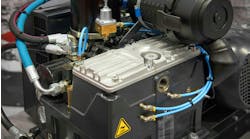The transition to electrification brings with it many design decisions. Among these is determining whether it makes sense to replace some or all of the components within a fluid power system.
According to Jason Schneider, Principal Engineer – Team Lead, Electrified Powertrain at Drive System Design (DSD) — an engineering consultancy for future powertrains — this is something several of DSD’s customers are evaluating. When doing so, he said it is important to consider the entire system and how any potential changes to hydraulic or pneumatic components will impact overall performance.
Power & Motion spoke with Schneider about the potential impacts of electrification on fluid power systems, current challenges as well as key factors to consider during the design process.
Power & Motion (P&M): We know electrification is on the rise in a lot of applications. How is Drive System Design seeing electrification impacting other system designs, particularly hydraulics and pneumatics?
Jason Schneider (JS): We're seeing a lot of our customers who traditionally have used hydraulics to distribute energy throughout a vehicle system, whether it's for propulsion or auxiliary components, considering replacing some or even all of those components with electrified counterparts. There's efficiency improvements to be had, there's controllability improvements to be had and there's even things on the NVH (noise, vibration and harshness) side; electronics are typically quieter than hydraulics or pneumatics, and then maintainability, as well [can be improved]. There's definitely a lot of interest in the customer base in transitioning some or all of a typical hydraulic or pneumatic system into electrified components.
READ MORE: The Impacts of Electrification on Fluid Power Systems
P&M: What key considerations will need to be kept in mind when developing hydraulic or pneumatic systems for electric vehicles or equipment?
JS: It's fairly obvious, but with electrification efficiency and weight is king. The less efficient you are, the more battery you need to carry which makes you heavier, which [creates] the need for an even larger battery to be on the vehicle. That is the key consideration when you're electrifying your components is understanding the impacts [on efficiency and weight].
If you have a system where part of it is being electrified, and you're still maintaining the hydraulics or pneumatics, you may need to consider redesigning or modifying the design [of the hydraulics or pneumatics] to optimize for reduced weight or efficiency. Because if you're going through the effort of getting into an electrification scheme, then you're going to want to be looking at the system-level attributes, including efficiency, and supporting range or the CO2 (carbon dioxide) footprint, [and] overall system-level goals. At the same time, [while] efficiency and weight are important, but you can't always get the most efficient, most lightweight system at the right costs. So, there is still system-level analysis that needs to happen while you're looking to update or migrate into electrification. When you look at a system, you may find it would be cool to replace a hydraulic component with an electrified one but at the system level, it actually might not make sense. There is still a system engineering need when you're looking at doing these conversions.
At DSD, that's what we're about, from the system point of view — we do concept studies and trade off studies all the time to really look at, when you zoom out, what is the right solution before you dive deep into the technical details.
The last thing, as well, is packaging. The space claim of electrified components can be a lot different than the hydraulic counterparts. And the battery is a totally different component that you need to think about packaging in the vehicle. Where is it going to go? How is it going to affect vehicle dynamics? Those types of things. That's an example of a system that you need to add to the vehicle for electrification. But when you do replace some hydraulics or pneumatics, you can remove a lot of things as well, a lot of hoses and other hydraulic parts of the system, so it maybe opens up more space. But that's something I think, from an optimization point of view, that's kind of yet to come because a lot of the industries that are replacing hydraulic components with electrified ones are just getting into this proof of concept [stage] where they want to rip some stuff out and put stuff in and see how it works and evaluate. But they're not really looking at the whole vehicle architecture as a system yet to optimally design that vehicle architecture knowing that they're going to have different sub-components.
There's a lot of things to consider, is the short answer. But it's a pretty interesting space.
P&M: You mentioned before there are sometimes changes necessary to the hydraulic or pneumatic components and systems, do you have examples of what those changes would be and how they would benefit use in electrified vehicles and machines?
JS: The obvious initial component to look at replacing would most likely be a mechanically driven pump or a hydraulic motor that could be replaced with an electric motor. To what I was saying before, [with] a hydraulic motor, for example, you can not only take it out but you could take all of the hydraulic hoses and [other components] that were feeding it and rip those out of the system too and replace it with a standalone electric machine. Of course, you have to connect it with wires but those typically take up less space.
I think the second area is the replacement of specific actuators, pneumatic or hydraulic actuators like valves for example. Electric actuators in general are typically easier to control and easier to control more precisely so that opens up, from a controls point of view, potential efficiency gains and system efficiency gains because of the improved controllability. The control systems and the software, they're going to [provide] more functions and more sophisticated algorithms that could help the overall system performance or efficiency. So even a couple of steps removed from the actual actuator, you could have a need for a different controller or a bigger CPU with more throughput so that you can take advantage of the additional controllability and do more clever things on the control side.
P&M: Do you see electrification maybe bringing some advantages or opportunities to fluid power components and systems?
JS: Yeah, definitely. We've mentioned a few already, but certainly efficiency, controllability, maintainability, and serviceability. The NVH as well; the big, high power fluid systems are incredibly loud and noisy, and electrification is an opportunity to help [improve] that driver or user experience quite a bit.
Safety [is another area] as well. Obviously, high voltage is kind of another beast in terms of safety, but if the systems are designed correctly, they are actually quite safe. With hydraulics or pneumatics, I would say they're a little bit less safe, especially as things wear, as things get some durability cycles on them. And if you're in service mode or maintenance mode, they can be quite dangerous. Even if you're following the best guidance for serviceability, there's things with pneumatics and hydraulics that can be quite dangerous.
So, I think those are the high-level advantages of this shift.
READ MORE: How to Safely Work with High-Voltage Systems
P&M: Conversely, what are some of the key challenges or issues electrification presents for fluid power?
JS: We touched on it a little bit with the increased controllability, that will drive complexity. If you want to do more clever things to get more efficient, you're going to drive the complexity of the controls. That definitely could be a challenge or something to work through. The electrification components [and] the electrification of a vehicle is probably going to cost you a little bit more; certainly an upfront engineering cost and likely a manufacturing cost. Electrification isn't cheap but the opportunity there is that it costs a bit more from a component perspective, but at a system level you reap the benefits of that additional cost. So, again, it's system level [analysis] — this motor, this battery, and this component is going to cost me X amount more, can I gain that back at a vehicle level? It comes back to the system analysis and understanding that.
I think there's some areas where hydraulic systems can't be replaced because of power limitations, at least where we're at today [technology wise]. The electrified systems won't be able to supply the same amount of power for the higher-power applications where pneumatics or hydraulics are currently used. There's a set of replacement opportunities that could be challenging because of the power level and then beyond that, you're just going to say, no it's not worth it, we can’t achieve it. Below that, here's where it makes total sense. But if you're on that line, it can be a challenge to make it work.
I think the last one, and maybe even the most challenging one, which comes not even at the vehicle system level but at a larger system level [is] with charging infrastructure. A lot of applications that do use pneumatics or hydraulics are off-highway; there's already a lot of attention and concern about where charging stations are going to be placed and how many we need for electrification of on-highway vehicles. Off-highway, it's even farther down the road. You can't really go to full electrification at all if you don't have a good way to charge these vehicles from the grid. So, that's definitely a challenge as well.
P&M: How do you foresee fluid power systems evolving with the growth of electrification, and will hydraulics or pneumatics ever be fully replaced?
JS: To answer the first question, DSD specializes in this kind of system integration area and I think there is a lot of potential for reaping the benefits of integrating electrified systems with traditionally hydraulic or pneumatic systems to become a hybrid, in the short term, combining the best features of both. And I do think there's a place for both in the future, certainly medium term, and probably long term. Maybe on the long-term side if we can increase power levels and get the infrastructure and battery technology to the place that everybody is aiming for, you could see a full replacement [of hydraulics and pneumatics]. But I think that's a ways away, there will be a gradual shift which we've already started to see [and are helping] our customers do.
So far, it's been fairly pragmatic about what and when to shift certain components. The shift will continue to move that way, there's sustainability and efficiency initiatives that are being driven from all levels, down from the government but also within private companies that are trying to increase efficiency and sustainability. Electrification is a way to go when you're trying to do that.
I think as you electrify more systems, the systems that aren't electrified, people will begin to look at those and say, okay, how can we redesign these to make them more compatible with electrified systems. [This involves] making them smaller, lighter, or changing their shape so that you can package your electrified components in a better way. So overall optimization, again, at the system level.
Those are the major trends that we see and are supporting our customers in achieving at this point.


